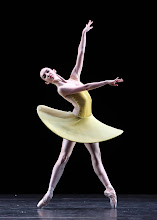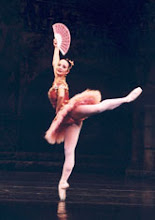http://answers.yahoo.com/
http://www.blogcatalog.com/
| Ballet Combinations | ||||||||||||
| Center Practice | ||||||||||||
| Turns: Double pirouette single fouette, attitude turn, repeat. | ||||||||||||
| Tombe, pas de bouree, (into fourth position) passe, fourth...Tombe, pas de bouree, (into fourth again) single pirouette (land in fourth)...and continue all the way up to a quad pirouette. | ||||||||||||
| Petite Allegro Pas de chat to pas de bouree right and left, 3 sissones in arabesque,pas de bouree, repeat left. | ||||||||||||
| 4 echappe sautés, one echappe sauté batue to coupe, pas de bouree. Sissone ferme right and left, pirouette en de'hor, and repeat to the other side. | ||||||||||||
| Waltz Two balances a cote (starting right), balance en avant and balance turning. Pique first arabesque on the right, step through onto left foot, turn from the right shoulder and grand rond en l'air with right leg. Tombe pas de bourree, attitude to the corner (left) en pointe, fondue and extend to arabesque, chasse through to right fourth croise. Pirouette right en dedans, land on left leg and right in coupe. Step on right leg into grand rond en l'air with left, Soutenou and finish in fifth. | ||||||||||||
| Grande allegro: Pique arabesque, chasse, fouette, chasse, tour jete, double pirouette. | ||||||||||||
| Tombe, pas de bouree, glissade, grande jete, contretemps, tombe, pas de bouree, glissade, grande jete, glissade grande jete, pique first arabesque, falli, pirouette to fourth. | ||||||||||||
CLASSICAL BALLET
Adult Ballet
Barre-work teaches the basics of working in a turned out position, stretching and pointing the
feet, proper alignment of the body and strengthening the muscles of the legs and torso for
beginning dancers. Some of the same exercises done at the barre are also done in the center
for balance, control and the use of the arms in coordination with the legs. Small jumps are
done in the center. Simple walks, runs, waltz steps and chassées are done across the floor.
Ballet II
Simple basic exercises begin at the barre. These exercises develop the muscles of the legs,
their turn-out, extension and plié as well as their coordination with the torso, arms and head.
In addition, elementary movement coordination is taught as well as the proper distribution of
body weight over both legs and on one leg; mastery of the positions of the feet and arms are
focused on intently. Concepts of en dedans, en dehors, demi-pointe on both legs and one leg
are also introduced. Transition steps such as glissade, pas de bourré, soutenu, etc. are
mastered at this level. Simple jumps are done in the center. Short combinations with long
jumps and waltz steps, pas de bourrées are done across the floor.
Understanding basic ballet positions, to most people, means the five positions of the feet. Yet, a position more basic than those, is the position your body is in when you are standing with your feet parallel, in a comfortably held good posture. Understanding your personal starting point will help you progress faster.
You may not be asked to do this in a beginner (including adult beginner) ballet class. If your teacher skips this step, you can do it at home.
Stand in front of a mirror in your ballet clothes, or wear shorts and a tight top so you can see your knees, and your general posture. A hard floor is better than a plush carpet. Here are things to notice:
- are your feet evenly touching the floor with your weight distributed evenly between the center of your heel, the little toe joint area and the big toe joint area (this is often called "tripod")
- do your ankles roll inward or outward
- do your calves naturally stand in a straight line upward to your knees, or do they bow out slightly
- do your knees face the front or slightly inward
- are your hips and shoulders level or even a tiny bit uneven
- standing sideways to the mirror, are your knees above your ankles or do they over-straighten and curve behind you
- is there a small curve inward at the small of your back (everyone's natural curve will look different in relation to the shape of their gluteal muscles)
- can you pull the very bottom of your abdomen up and in without changing the tilt of your pelvis
- is your chest lifted allowing your shoulders to relax, not drooping forward
- is your neck relaxed - turn your head slightly from side to side, and up and down a little, to get into a relaxed position
Of course it is your teacher's job to notice all of this, but it gets you ahead if you can see these factors, and correct yourself as much as possible. Always ask for help if you need more information to be sure.
All of the above will determine how you will stand in first, second, third, fourth and fifth ballet positions. Aside from introducing the element of turn out, your understanding of posture and how your feet are placed on the floor, will determine how you progress learning basic ballet positions.
You may not be asked to do this in a beginner (including adult beginner) ballet class. If your teacher skips this step, you can do it at home.
Stand in front of a mirror in your ballet clothes, or wear shorts and a tight top so you can see your knees, and your general posture. A hard floor is better than a plush carpet. Here are things to notice:
- are your feet evenly touching the floor with your weight distributed evenly between the center of your heel, the little toe joint area and the big toe joint area (this is often called "tripod")
- do your ankles roll inward or outward
- do your calves naturally stand in a straight line upward to your knees, or do they bow out slightly
- do your knees face the front or slightly inward
- are your hips and shoulders level or even a tiny bit uneven
- standing sideways to the mirror, are your knees above your ankles or do they over-straighten and curve behind you
- is there a small curve inward at the small of your back (everyone's natural curve will look different in relation to the shape of their gluteal muscles)
- can you pull the very bottom of your abdomen up and in without changing the tilt of your pelvis
- is your chest lifted allowing your shoulders to relax, not drooping forward
- is your neck relaxed - turn your head slightly from side to side, and up and down a little, to get into a relaxed position
Of course it is your teacher's job to notice all of this, but it gets you ahead if you can see these factors, and correct yourself as much as possible. Always ask for help if you need more information to be sure.
All of the above will determine how you will stand in first, second, third, fourth and fifth ballet positions. Aside from introducing the element of turn out, your understanding of posture and how your feet are placed on the floor, will determine how you progress learning basic ballet positions.
Assess Posture:
Whether you are a younger beginner or an adult beginner, being able to self-assess your posture gives you a place to start learning technique from.
Standing sideways to a mirror, lift your chest a little, breathe easily, and notice how you stand. Look to see if your shoulders are relaxed to the side of your torso, as opposed to resting forwards.
If your shoulders do rest a little forward, here is a very easy stretch. Commonly called the doorway stretch - stand in a doorway. See if you can raise your arms so your elbows are shoulder level, and your forearms are raised upwards at a 90 degree angle to your upper arms. With your palms facing forwards, can you press your forearms into the door jamb on either side? If not, you will stretch one side at a time.
So, pressing either both or one forearm into the door jamb, lean forward until you feel a stretch across your chest. Just stretch gently, holding for 10 seconds, and releasing. You can do this several times a day - whenever you walk through a doorway! Gradually you will see that your shoulders will relax more towards the side, in line with the plane your ears occupy.
The lower part of your posture is your pelvis. If you have equal flexibility in your quads, or front thigh muscles, and hamstrings, on the back of your thighs, and also your postural abdominal muscles, your pelvis should rest in a "neutral" position. This means it is not pulled into a tilt in either direction due to tight muscles. Therefore your back does not sway, increasing the curve at the back of your waist, nor does the pelvis tilt back, pulling the natural curve into a straight line.
So flexibility affects posture. Just this one detail of many finer details is your starting point. Your posture, dancing in point shoes, is going to be exactly how you are standing now. For this reason you want to build strength from a correct posture. "...so how can I improve the basics of..." starts with this.
Standing sideways to a mirror, lift your chest a little, breathe easily, and notice how you stand. Look to see if your shoulders are relaxed to the side of your torso, as opposed to resting forwards.
If your shoulders do rest a little forward, here is a very easy stretch. Commonly called the doorway stretch - stand in a doorway. See if you can raise your arms so your elbows are shoulder level, and your forearms are raised upwards at a 90 degree angle to your upper arms. With your palms facing forwards, can you press your forearms into the door jamb on either side? If not, you will stretch one side at a time.
So, pressing either both or one forearm into the door jamb, lean forward until you feel a stretch across your chest. Just stretch gently, holding for 10 seconds, and releasing. You can do this several times a day - whenever you walk through a doorway! Gradually you will see that your shoulders will relax more towards the side, in line with the plane your ears occupy.
The lower part of your posture is your pelvis. If you have equal flexibility in your quads, or front thigh muscles, and hamstrings, on the back of your thighs, and also your postural abdominal muscles, your pelvis should rest in a "neutral" position. This means it is not pulled into a tilt in either direction due to tight muscles. Therefore your back does not sway, increasing the curve at the back of your waist, nor does the pelvis tilt back, pulling the natural curve into a straight line.
So flexibility affects posture. Just this one detail of many finer details is your starting point. Your posture, dancing in point shoes, is going to be exactly how you are standing now. For this reason you want to build strength from a correct posture. "...so how can I improve the basics of..." starts with this.




